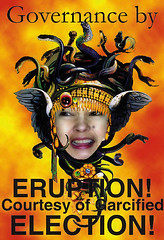Scapegoating minorities
Bottom Line
By Marvin Bionat
Many in the political right have merrily espoused and vigorously circulated the view that the Community Reinvestment Act (CRA) of 1977 is to blame for the current financial crisis. CRA was crafted to encourage banks to reverse “redlining,” the practice of denying low- to middle-income minority groups loans that were in fact available to low-income whites. In cases where they were actually able to apply for a mortgage, African-American borrowers, according to a US Commission on Civil Rights Report in 1961, were required to pay higher down payments. After CRA, certain financial institutions are required to address the credit needs of the local community in which they are chartered without discrimination and “consistent with safe and sound operations.”
To establish the link between defaulting minorities and the US financial crisis, one would hope that the scapegoating proponents would at least show some relevant data. Instead, they point to the Clinton administration’s adding of “massive new provisions to authorize subprime loans to be made … [and to allow] the securitization of CRA loans containing subprime mortgages.” Without citing specific pieces if legislation, they go on to attribute some US$1 trillion in subprime loans to CRA. (See, for example, Terry Easton’s article “Watching the House Burn Down: What Caused Our Economic Crisis?”).
To be sure, many members of minority groups, just like white America, have defaulted and are continuing to default on their mortgage loans. But to directly link CRA and defaulting minorities to the financial crisis is stretching it too far. First, in response to concerns that CRA would undermine bank profitability, a 1997 report by Federal Reserve economists concluded that “CRA lenders active in lower-income neighborhoods and with lower-income borrowers appear to be as profitable as other mortgage-oriented commercial banks.” In 2007, Federal Reserve Chair Ben Bernanke said that “managers of financial institutions found that these loan portfolios, if properly underwritten and managed, could be profitable” and that the loans “usually did not involve disproportionately higher levels of default.” Michael S. Barr, a University of Michigan law professor and a former Treasury Department official, confirmed this view. Barr, in his testimony to Congress in February 2008, noted that about 50% of subprime loans were made by independent mortgage companies not covered by CRA, and another 25% to 30% were made by partially covered bank subsidiaries and affiliates. He estimated that only 25% of subprime loans were issued by banks fully covered by CRA, adding that “the worst and most widespread abuses occurred in the institutions with the least federal oversight.”
Harvard University’s Joint Center for Housing Studies (JCHS), in a study of the impact of CRA during most of President Clinton’s term, also suggested a less than central CRA role in the current crisis: “In combination, the changing industry structure, along with the fact that CRA expanded the capacity of all industry players to better serve lower-income borrowers, has diminished the extent that CRA-regulated organizations now lead the market. Econometric analysis suggests that on average over the period 1993 to 2000, CRA may have increased the share of loans going to CRA eligible borrowers by 2.1 percentage points (or from 30.3% to 32.4%). Estimates for individual years suggest, however, that the CRA impact has declined from 3.7 percentage points in 1993 to 1.6 percentage points in 2000.”
In its 2008 report on home ownership, JCHS attributed the subprime turmoil not to CRA but to more obvious factors: “The roots of the crisis lie in unusually tight housing markets, historically low interest rates, and investor demand for high returns in the first half of this decade. This was also a period of unprecedented global economic growth, and capital was pouring into the United States. American homebuyers took advantage of the low interest rates these conditions produced to snap up properties. But with market tight and multiple bidding situations common, home prices started to climb much faster than incomes. Even subprime loans, which predictably perform worse than prime loans, were seen as safe enough investments because home values were appreciating so quickly.”
The same JCHS report further pointed to what is now widely considered as unbridled investor greed: “In their search for ever-greater returns, investors borrowed short-term money from banks to purchase securities backed by subprime mortgages. By leveraging their investments, they hoped to boost their profits but exposed themselves to refinance risk each time they had to roll over their debt. Meanwhile, the cash flows associated with mortgage payments were sliced up and in some cases pooled with nonresidential loans, obscuring how deterioration in loan performance would affect many bond issues.”
Subprime loans were aggressively marketed even in poor communities not because of CRA, but because they became so profitable. Even housing advocacy groups like ACORN raised objections and warnings on what clearly became unmitigated predatory lending.
A slew of other experts have taken the cudgels to disprove the blame-the-CRA malarkey. Economist Luci Ellis, in a Bank for International Settlements working paper, concurred that “there is no evidence that the Community Reinvestment Act was responsible for encouraging the subprime lending boom and subsequent housing bust.” Ellen Seidman, former director of the US Office of Thrift Supervision who now works at the New America Foundation, likewise affirmed that the CRA had no bearing on the housing bubble in the US.
In addition, Janet Yellen, president of the San Francisco Federal Reserve, pointed out that independent mortgage companies not covered by CRA offered high-priced loans at more than twice the rate of the banks and thrifts. Yellen debunked the “tendency to conflate the current problems in the subprime market with CRA-motivated lending.”
Corollary to blaming the CRA for the current economic crisis, the political right is also accusing Democrats for having cuddled Fannie Mae and Freddie Mac. Ironically, it was Rick Davis, McCain’s current campaign manager, who actually worked for Freddie and Fannie from 2000 to 2005 as chair of the Homeownership Alliance, an organization created to lobby Congress for legislation favorable to the two government-sponsored enterprises. The Alliance’s mandate was to stave off Congressional attempts at regulation, and Davis was paid US$30,000 a month for his services.
The extreme political right likes to blame minorities and the influx of people from the Third World for America’s decline, and arguments along the CRA line can easily resonate among voters who resent — latently, moderately, or gravely — minorities. In their recent column, Jack and Suzy Welch compared the financial crisis to Agatha Christie’s Murder on the Orient Express, in which one murder victim created a slew of compelling suspects. Just as the murder of Mr. Ratchett actually involved all the suspects, the US financial crisis was brought about by a confluence of various factors and thus cannot be attributed to just one “perpetrator.” For the political right to pin the blame on some poor Black or Hispanic guy seated at the back of the Orient Express is patently unfair and does not contribute to finding the right solution to America’s current economic debacle.
************************************************************************
 Marvin Bionat is the creator of PhilippineUpdate.com, a news and views site that has served as a virtual platform that promotes various advocacies, including the political empowerment of overseas Filipinos and accountability in government. He wrote the National Bookstore bestseller How to Win (or Lose) in Philippine Elections (Anvil Publishing, 1998) and is now based in the
Marvin Bionat is the creator of PhilippineUpdate.com, a news and views site that has served as a virtual platform that promotes various advocacies, including the political empowerment of overseas Filipinos and accountability in government. He wrote the National Bookstore bestseller How to Win (or Lose) in Philippine Elections (Anvil Publishing, 1998) and is now based in the U.S.
By Marvin Bionat
Many in the political right have merrily espoused and vigorously circulated the view that the Community Reinvestment Act (CRA) of 1977 is to blame for the current financial crisis. CRA was crafted to encourage banks to reverse “redlining,” the practice of denying low- to middle-income minority groups loans that were in fact available to low-income whites. In cases where they were actually able to apply for a mortgage, African-American borrowers, according to a US Commission on Civil Rights Report in 1961, were required to pay higher down payments. After CRA, certain financial institutions are required to address the credit needs of the local community in which they are chartered without discrimination and “consistent with safe and sound operations.”
To establish the link between defaulting minorities and the US financial crisis, one would hope that the scapegoating proponents would at least show some relevant data. Instead, they point to the Clinton administration’s adding of “massive new provisions to authorize subprime loans to be made … [and to allow] the securitization of CRA loans containing subprime mortgages.” Without citing specific pieces if legislation, they go on to attribute some US$1 trillion in subprime loans to CRA. (See, for example, Terry Easton’s article “Watching the House Burn Down: What Caused Our Economic Crisis?”).
To be sure, many members of minority groups, just like white America, have defaulted and are continuing to default on their mortgage loans. But to directly link CRA and defaulting minorities to the financial crisis is stretching it too far. First, in response to concerns that CRA would undermine bank profitability, a 1997 report by Federal Reserve economists concluded that “CRA lenders active in lower-income neighborhoods and with lower-income borrowers appear to be as profitable as other mortgage-oriented commercial banks.” In 2007, Federal Reserve Chair Ben Bernanke said that “managers of financial institutions found that these loan portfolios, if properly underwritten and managed, could be profitable” and that the loans “usually did not involve disproportionately higher levels of default.” Michael S. Barr, a University of Michigan law professor and a former Treasury Department official, confirmed this view. Barr, in his testimony to Congress in February 2008, noted that about 50% of subprime loans were made by independent mortgage companies not covered by CRA, and another 25% to 30% were made by partially covered bank subsidiaries and affiliates. He estimated that only 25% of subprime loans were issued by banks fully covered by CRA, adding that “the worst and most widespread abuses occurred in the institutions with the least federal oversight.”
Harvard University’s Joint Center for Housing Studies (JCHS), in a study of the impact of CRA during most of President Clinton’s term, also suggested a less than central CRA role in the current crisis: “In combination, the changing industry structure, along with the fact that CRA expanded the capacity of all industry players to better serve lower-income borrowers, has diminished the extent that CRA-regulated organizations now lead the market. Econometric analysis suggests that on average over the period 1993 to 2000, CRA may have increased the share of loans going to CRA eligible borrowers by 2.1 percentage points (or from 30.3% to 32.4%). Estimates for individual years suggest, however, that the CRA impact has declined from 3.7 percentage points in 1993 to 1.6 percentage points in 2000.”
In its 2008 report on home ownership, JCHS attributed the subprime turmoil not to CRA but to more obvious factors: “The roots of the crisis lie in unusually tight housing markets, historically low interest rates, and investor demand for high returns in the first half of this decade. This was also a period of unprecedented global economic growth, and capital was pouring into the United States. American homebuyers took advantage of the low interest rates these conditions produced to snap up properties. But with market tight and multiple bidding situations common, home prices started to climb much faster than incomes. Even subprime loans, which predictably perform worse than prime loans, were seen as safe enough investments because home values were appreciating so quickly.”
The same JCHS report further pointed to what is now widely considered as unbridled investor greed: “In their search for ever-greater returns, investors borrowed short-term money from banks to purchase securities backed by subprime mortgages. By leveraging their investments, they hoped to boost their profits but exposed themselves to refinance risk each time they had to roll over their debt. Meanwhile, the cash flows associated with mortgage payments were sliced up and in some cases pooled with nonresidential loans, obscuring how deterioration in loan performance would affect many bond issues.”
Subprime loans were aggressively marketed even in poor communities not because of CRA, but because they became so profitable. Even housing advocacy groups like ACORN raised objections and warnings on what clearly became unmitigated predatory lending.
A slew of other experts have taken the cudgels to disprove the blame-the-CRA malarkey. Economist Luci Ellis, in a Bank for International Settlements working paper, concurred that “there is no evidence that the Community Reinvestment Act was responsible for encouraging the subprime lending boom and subsequent housing bust.” Ellen Seidman, former director of the US Office of Thrift Supervision who now works at the New America Foundation, likewise affirmed that the CRA had no bearing on the housing bubble in the US.
In addition, Janet Yellen, president of the San Francisco Federal Reserve, pointed out that independent mortgage companies not covered by CRA offered high-priced loans at more than twice the rate of the banks and thrifts. Yellen debunked the “tendency to conflate the current problems in the subprime market with CRA-motivated lending.”
Corollary to blaming the CRA for the current economic crisis, the political right is also accusing Democrats for having cuddled Fannie Mae and Freddie Mac. Ironically, it was Rick Davis, McCain’s current campaign manager, who actually worked for Freddie and Fannie from 2000 to 2005 as chair of the Homeownership Alliance, an organization created to lobby Congress for legislation favorable to the two government-sponsored enterprises. The Alliance’s mandate was to stave off Congressional attempts at regulation, and Davis was paid US$30,000 a month for his services.
The extreme political right likes to blame minorities and the influx of people from the Third World for America’s decline, and arguments along the CRA line can easily resonate among voters who resent — latently, moderately, or gravely — minorities. In their recent column, Jack and Suzy Welch compared the financial crisis to Agatha Christie’s Murder on the Orient Express, in which one murder victim created a slew of compelling suspects. Just as the murder of Mr. Ratchett actually involved all the suspects, the US financial crisis was brought about by a confluence of various factors and thus cannot be attributed to just one “perpetrator.” For the political right to pin the blame on some poor Black or Hispanic guy seated at the back of the Orient Express is patently unfair and does not contribute to finding the right solution to America’s current economic debacle.
************************************************************************
 Marvin Bionat is the creator of PhilippineUpdate.com, a news and views site that has served as a virtual platform that promotes various advocacies, including the political empowerment of overseas Filipinos and accountability in government. He wrote the National Bookstore bestseller How to Win (or Lose) in Philippine Elections (Anvil Publishing, 1998) and is now based in the
Marvin Bionat is the creator of PhilippineUpdate.com, a news and views site that has served as a virtual platform that promotes various advocacies, including the political empowerment of overseas Filipinos and accountability in government. He wrote the National Bookstore bestseller How to Win (or Lose) in Philippine Elections (Anvil Publishing, 1998) and is now based in the Other articles from the author:
Related POGB article:
- SC Dismissed Republican Ohio Bogeyman Ruse on Voter Fraud
- Black & Minorities the Usual Scapegoats in Sub-Prime Debacle

POGB will not sell, exchange, use or allow any 3rd party access to your email for
any other purposes without exception, email exclusively for article updates only.
























0 Speak Out:
Post a Comment